So you have taken a step in the right direction. You have started prepping and honing your survival skills. However, even as you become more experienced there will likely be times when you overlook important skills, preparations, and procedures in your survival strategy.
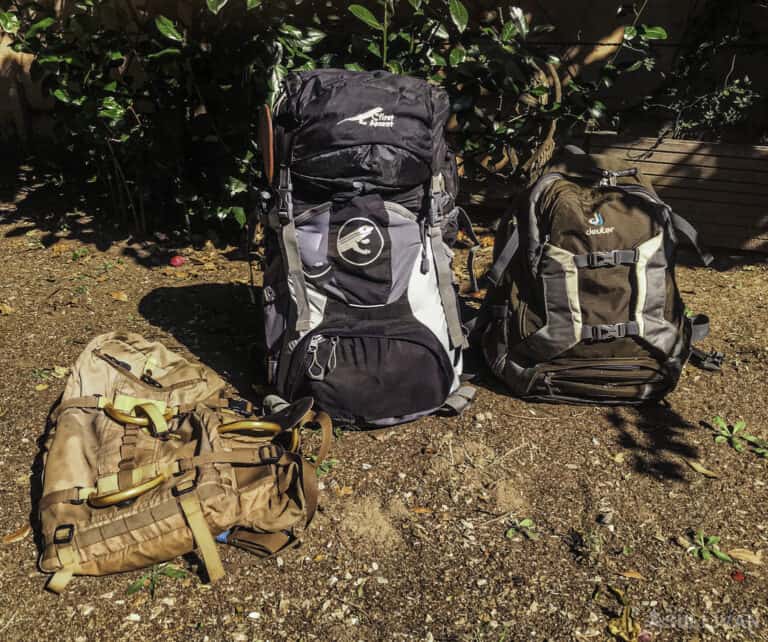
This can result in “blind spots” that can spell certain disaster in the wrong circumstances! Everyone is a victim of their own frame of reference, and preppers are not exempt from this.
The sources through which most survivalists learn are fairly consistent. This means that I see the same blind spots cropping up again and again even among the most diligent preppers, both beginners and seasoned veterans.
This can run the gamut from fire-starting to improvised shelter creation or emergency communications protocols You never want to put yourself in a situation where you must use or “develop” a technique for the first time in an actual survival situation.
In this article, I’ll share with you a list of the most common prepping blind spots I see occur time and time again so that you can be sure there are no gaps in your knowledge base or weaknesses in your survival plan! We’ll get into them immediately just below.
#1. Plenty of Knowledge, But No Experience
By far the most common blind spot for prepping and survival is practice. Too many people take the time to read up on survival techniques but never take the time to try them out in advance.
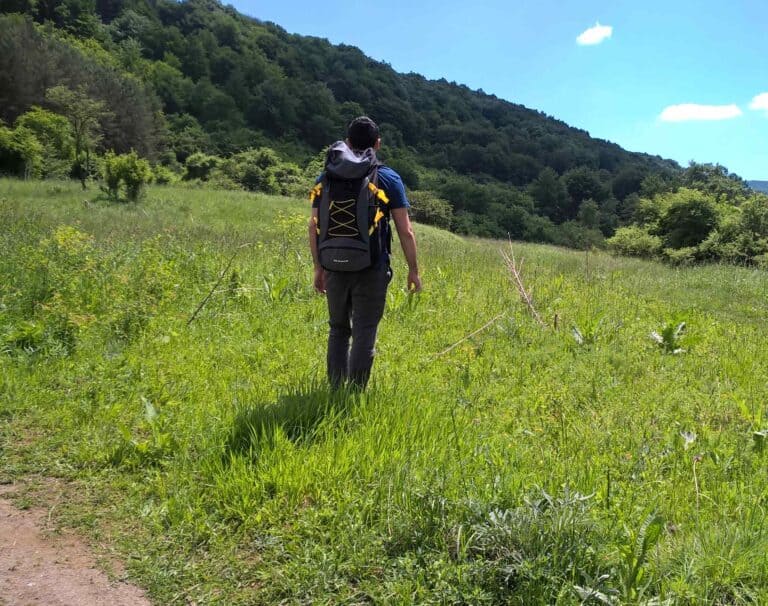
Chances are you know somebody who always has their head buried in a book, some manual, or deep into a website archive on the internet and search of ever more specialized knowledge that will, hopefully, help them survive in a crisis situation.
The idea is if they have read about it, heard about it, or generally seen it all before then nothing will surprise them and there will be no problem they cannot handle. That is a fine idea, and I applaud their tireless study but there is one fatal flaw in their plan…
These preppers more than most are content to read, read, read- without applying what they have learned in any practical way!
This results in a prepper that has extensive databases in their head but little in the way of confidence and certainty in application because they lack the experience, problem-solving skill, and “muscle memory” of doing it for real, even in a simulated setting.
This blind spot is so insidious because it is so universal that it can apply to anything. There are preppers that know every single dangerous insect and snake in the region like the back of their hand- so long as they see it printed on beautiful photographic stock!
I know folks who think they are the second coming of Bruce Lee they are so versed in hand-to-hand combat and martial arts- except they have never taken the risk I’m getting their ego dashed inside the ring during a bout of sparring!
You will never have real ownership over your knowledge until you apply it again and again in a real-world setting. Only then will it be legitimate, and only then will you be able to count on it.
#2. Fire-Starting
Starting a fire is one of the four pillars of survival and is one of the most important techniques you can learn.
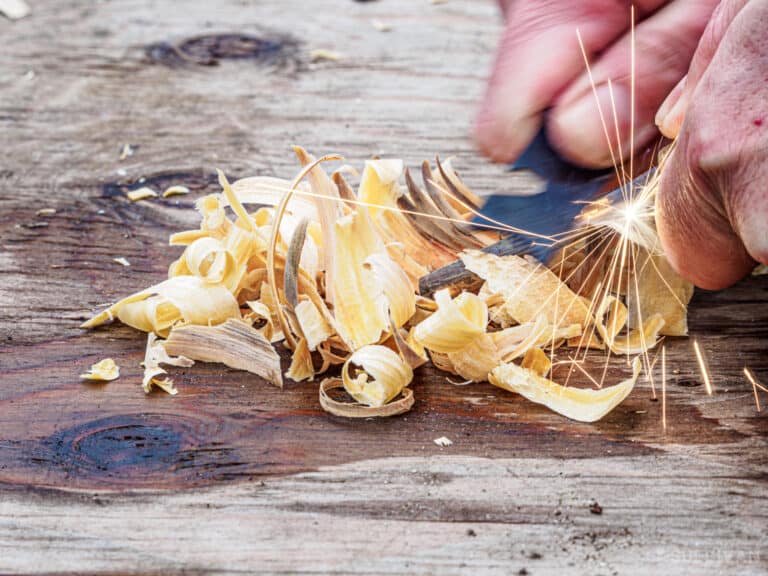
Fire can maintain body temperature, purify water, cook meat, and keep away insects and predators. However, many preppers are hopelessly under-prepared to build and maintain a fire because they underestimate how difficult it can be.
The first mistake people make is in underestimating the variables: assuming that building a fire can be done quickly. Depending on the conditions and the quality of the wood, it can sometimes take hours to get a fire going.
Damp wood is another issue, as is the type of wood. Controlling your fire safely at the desired level is far from easy, as many amateurs find out the first time they try to build a cooking fire.
Another blind spot is thinking that all ignition sources require equal amounts of skill. It is a simple thing to use a lighter or strike a match, but a ferro rod requires more skill and practice to reliably spark and something like a fresnel lens is more difficult still.
Most difficult of all, and something that is seen as a sort of prepping merit badge, is using primitive friction methods to get the fire going.
Never assume that you will always have a lighter handy and that it will be functional and fueled; you must learn and practice multiple fire-starting methods to be truly prepared for an outdoor survival situation.
#3. Improvised Shelter Techniques
Improvised shelter creation, really the art of thermoregulating your core temperature, is an essential survival skill no matter what kind of disaster you are preparing for and where you live. Most preppers rely wholly on tents, sleeping bags and other production outdoor gear and clothing to accomplish this.
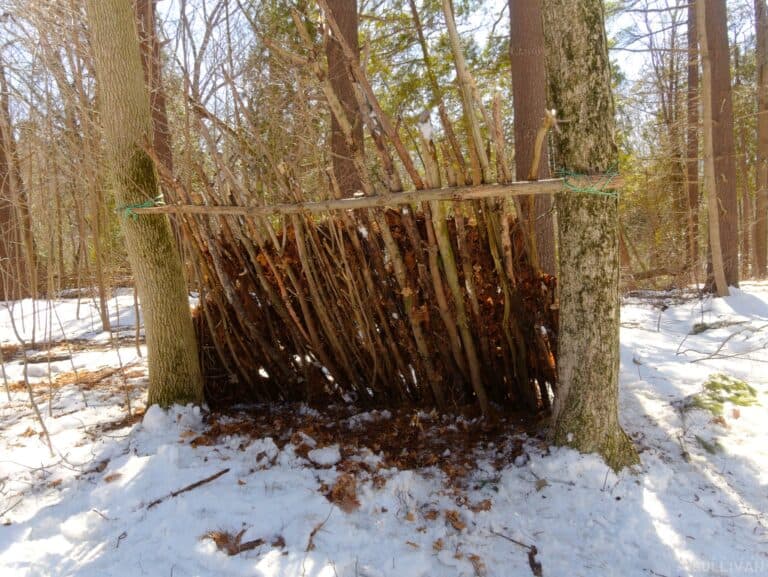
As I mentioned above under the fire starting section, exposure is a major killer all around the world and one of the most common threats that will arise in the aftermath of a disaster or some other crisis.
You must be able to keep your body’s core temperature around 98.6 degrees, or you will probably be heading for the afterlife in short order.
This is most obviously an issue in cold climates, but also important in hot ones. You can die from becoming too hot or too cold for too long.
It is imperative that you know how to warm yourself, even without a fire, but also how to cool yourself using the resources you have available.
This is an easy task when you have purpose-made equipment like appropriate clothing, fans, heaters, air conditioning and so forth, but when you are surviving in a truly austere environment your shelter skills will be put to the test.
For instance, did you know it is possible to drastically warm yourself by creating a shelter from snow alone, something akin to the traditional igloo?
Did you know that lacking a sleeping bag you can easily create one that is surprisingly effective using nothing but large trash can liners and crumpled-up paper?
If you are living in a structure with no power that is growing too hot or too cold do you know how to create an appropriate “microclimate” within the structure to save energy and appropriately regulate your body temperature?
All of these skills are fairly rudimentary and easy to learn, but most preppers will respond to these questions with a wide-eyed stare and nothing more. Even quicker than a lack of water it is exposure that can kill you rapidly; a few hours is all it takes, second only to a lack of air.
Don’t miss the forest for the trees- perhaps halt stocking up on ammunition, food, and water until you learn a handful of methods for staying warm or staying cool no matter the ambient conditions.
The beam must be focused to the smallest point possible, and you must remain perfectly still. Friction fire is another ignition source that is very difficult.
The method is tough, but the hardest part is finding the right type of wood. In many cases, you’ll have to try several types of wood before finding one that will create an ember.
#4. Family Drills
Whether your family is on board with your prepping or not, there are certain scenarios in which everybody has to be on the same page
You must not be the only person who is interested in and more importantly, investing in the survival of the family unit.
A family must function as a team during a crisis or time will surely be wasted, and wasting time during a crisis often equates to loss of life.
No matter the scenario or scenarios you are preparing for, it is imperative that you go through basic survival drills with your family, and also drill under time pressure to complete certain procedures quickly and correctly.
This does not have to be run like a military-style boot camp, and indeed it should not be as such attitudes are highly likely to turn off small children and partners who are not as gung-ho as you are.
You can make it fun and indeed a bit of a novelty, akin to practicing a tornado drill at school. Make sure to reward everyone for a job well done, and once they have the basics mastered, ratchet up the difficulty, eventually culminating in a “live” drill that is as realistic as you can make it safely.
Don’t worry if you cannot get your family to complete anything more than basic drills with a good attitude, as even this rudimentary level of competency will translate into a significantly higher chance of survival when the chips are down.
So long as the human brain has a prior plan or playbook to draw from when dealing with a novel situation, reaction time will be greatly increased as will confidence. That is the whole point of doing regular drills!
The family that trains together survives together. Below are some examples of various drills you should be performing with your family:
When bugging in, specific people need to be in charge of inventory, security, pets, kids, and keeping it dark at night. Something as simple as keeping lights turned off can be difficult if not previously discussed and drilled.
When bugging out your family needs to know where the BOBs are kept, where you are headed, and how you are getting there. Practice grabbing all the needed items they are responsible for “on the clock”.
If there is a fire in the middle of the night, your family should know how to get outside by the quickest, safest route and be able to do so blindfolded.
They should know where each fire extinguisher is and how to use them, where each family’s rendezvous point is, and who is assigned to calling 911.
If your home starts to flood your family should know of a designated place in or on the home to which they can move, as well as other safe places on the high ground in your area.
In case of a real disaster that separates the family, they should know the redundant methods by which they can try to contact and link up with the family who might be elsewhere, as well as alternate places where they can get shelter and be accounted for,
Never forget that the overall proficiency of your family is governed by the weakest link, not the strongest. You will travel at the pace of your slowest person.
Focus on not only your development, but the development of the rest of your family. You may never get them to be as prepared as you are, but any improvement can make a huge difference.
#5. Living in Austere Conditions
Unfortunately, many preppers say they are about the survival life living in the wild or in the ruins of society, but they have absolutely no experience in doing so, not even any topical exposure.
When that fateful day finally comes and they are deprived of all or just most of the conveniences of modern life, it creates a sort of shock that can see them mentally or emotionally shut down. It is real, and something that you might have to deal with, so it is best to be prepared for it.
No matter how much you have stockpiled in the way of any given type of supply or provision, you should be prepared for living without it entirely if you yourself cannot create more, scavenge more, or obtain more in some way.
If you are prepared for living in the wild or in the ruins of civilization, you had better have some experience doing without for extended periods. If you cannot make yourself “do without” right now, what makes you think you’ll be able to at all when the time comes?
This is very much something you can put in the discipline category. Discipline is uncomfortable, it can even hurt.
But it is discipline, iron discipline, that will carry you through a stressful, trying situation when everything else seems lost and you feel like you have rolled snake eyes.
Survival in the wild or in the ruined city is not fun and will not feel good. If it feels good, you are camping, not surviving.
You must be willing to place yourself in those conditions now, while you can elect to (and also elect to leave) so you will not experience the shock I am talking about.
#6. Overdependence on BOB
On almost every prepping and survival website you will see a mention of bug-out bags. This pack is supposed to be filled with tools, provisions, and gear that can help you survive if you have to leave your home either on foot or by vehicle.
However, this is only one scenario that may play out. The gear you require to leave your home is going to be different than what you need to get back home from your workplace or plan to hunker down for the long haul at home.
Let us face it… there are plenty of situations in which you may not be home when SHTF or are unable to leave during the same. A daytime emergency would leave most survivalists trying to get home from work. You may have kids at school or daycare to grab on your way home.
Your SHTF scenario might be when your car breaks down in the wilderness, or when your plane goes down in the ocean. Any of these situations would be very different from voluntarily leaving your home.
Similarly, holding down the fort with family and trusted friends alike when the rest of society “way over there” seems to be embroiled in chaos is a smart bet.
This is where having your GHB (get-home bag) and a well-stocked, fortifiable home come into play. A get-home bag could be kept at work or in your car and would only have the tools needed to make it home at best speed.
A nicely supplied and stocked home that is a veritable fortress would similarly be a boon when the time comes to batten down the hatches.
Don’t fall into the trap of thinking you are all set once your BOB is packed and set somewhere handy!
#7 Limited Knowledge of Region / Biome
Longtime residents of any area are often proud of their claimed, intricate knowledge of their homeland and the surrounding area. There will be more than happy to tell you that they all know all the ways in or out, all the shortcuts, all the danger points, everything. But do they really?
Would they know how to get out of the county if every single road was rendered impassable or blocked?
Would they know which of the secret, wild highways were safe to travel in certain seasons and not others, and what dodgy characters might inhabit them? Do they know which streams and small rivers turn into deadly obstacles and for how long after a hard rain?
Do they know the important people and families are in certain parts of the county? Do they know of any natural or man-made spots that are suitable for seclusion and rest when in danger?
Do they know of both natural and man-made repositories of various resources, where they could go at a moment’s notice no matter where they are and expect to come up with guns, food, water, medicine or anything else that is needed when they are in dire straits?
Sure, lots of people can leave their home and find their way back when going by way of any of the cardinal directions, but that can hardly be said to be truly comprehensive knowledge of their hometown and the surrounding region.
That type of comprehensive knowledge might become very valuable in the aftermath of a serious disaster. It is not enough to know one or two routes, a Logging Road, and a little-fished pond somewhere in the back 40 acres. Intricate, complete knowledge of your local area should be placed high on your list of preps.
Regarding natural threats and resources, it makes sense that most of the effort put into prepping and survival is based on the environment in which you live. You plan for the plant and animal life in your area, the climate you are accustomed to, and the dangers found in that area.
However, your SHTF situation may take place somewhere completely different. You may be traveling when it happens, or you may choose to leave your home and head to a completely different area.
One way to correct this blind spot is to focus on plants and animals that can be found in multiple ecosystems. When learning about wild edible plants, there are several that can be found all around the world…
There are animals such as rats and mice that can be trapped in many different climates. Cold weather is by far the most dangerous type you can face, and hypothermia can be a risk even in the desert or rainforest. Find risks and resources that are common around the world.
Another option is to pick a few foreign environments and learn all you can about them. If you live in temperate forests like I do, you might study rainforests, the desert, and the Arctic.
This would give you a general understanding of the ways survival may be different. To take it a step further, you may plan a vacation or camping trip in these areas to test some of your knowledge.
#8. Fitness
You will rarely find a prepper who does not place an extreme emphasis on having the right supplies and the right gear.
Somewhat rarer, unfortunately, is a prepper who places an extreme emphasis on keeping their body in tip-top shape in order to better bolster their chances of survival no matter what the situation is.
There is no need to beat around the bush: fit people are more survivable in every conceivable situation than folks who are out of shape and flabby.
This is not to say that people carrying around just a few extra pounds or are without chiseled six-pack abs are not capable, or are helpless, but chances are if this statement raised your hackles you are one of the people I’m talking about.
A real survival situation will suffer no pretenders, tolerate no fakers. It could be a robber with a gun in your face or a knife to your throat, being trapped in an upside-down and burning car, or facing a hard swim to get out of raging flood waters that have broken the river’s banks.
The business of survival will entail strenuous aerobic and anaerobic exertion. You will have to run, climb, carry, pull, swim, swing, build and fight. If you are physically unprepared it will be tough, and can very easily spell the end of you.
Beyond simple physical prowess, fitness ensures that your brain will work at optimal levels by reducing mental and emotional stress when under the gun.
It is hard to think clearly and quickly when you’re gasping for breath and your vision is starting to red-out because you have been hustling up or down many flights of stairs with a weak ticker or sprinting away from the site of an active terror attack with all the grace of a winded walrus.
No excuses. If you are not in anything even approximating good shape, the time to start is now. This includes your diet. Almost no one can outwork a terrible diet. If you’re already in good shape, you can be in better shape. Take your physical fitness to the next level and you will drastically increase your survivability.
Other Considerations
In the end, blind spots will be different for each person. The key is identifying them early enough that you can do something about it. One way to do this is to get the opinions of others.
Spend some time with other preppers and survivalists. See what points of focus they have that you do not. Take any feedback that they can give you and ask all the questions you can.
Another way to find these blind spots is called mind mapping. The best way to do this is with a whiteboard or chalkboard. Write a specific point of focus or SHTF scenario on the board and then draw lines out from that to smaller categories. For example, ‘fire’ might be your main topic.
From there you have ‘ignition source’, ‘tinder’, ‘kindling’, ‘fuel’, ‘design’, ‘accelerants’, and ‘fire assistance products’. Under ‘ignition source’ you may have ‘ferro rod’, ‘friction fire’, ‘lenses’, ‘lighters’, ‘matches’, ‘electric’, ‘chemical’, and ‘air pressure’. This process will let you see if your survival plan is missing anything important.
The last and possibly best way to see blind spots in your survival and prepping is to test yourself. Not everybody has the time or resources to participate in survival challenges, but that is how I find my blind spots.
On my last challenge, I traveled 34 miles by foot over three days. I quickly realized that the climbing aspect of the challenge was a blind spot for me. I did not expect the terrain in this area to be so steep and rocky. If I did this challenge over again, I may take climbing gear to be a safer.
If you cannot do an all-out survival challenge, camping trips can be a good middle ground. Instead of making the whole experience a challenge, just test yourself on smaller aspects of survival.
Perhaps you leave the tent behind and make a shelter from natural materials, or bring the tent but agree to only eat food you find in the wild. Anything you can do to make yourself better prepared will help eliminate those blind spots and make you a better prepper and survivalist.
Conclusion
Almost every prepper will have blind spots that could sink them at the worst possible time. It could be a lack of knowledge, capability, or skills, but whatever form it takes you need to identify yours and shore them up as quickly as you can.
Review the ones presented in this article and meditate on what others you might have. You’ll be sure to discover a few that you can then deal with, making you a stronger prepper overall.
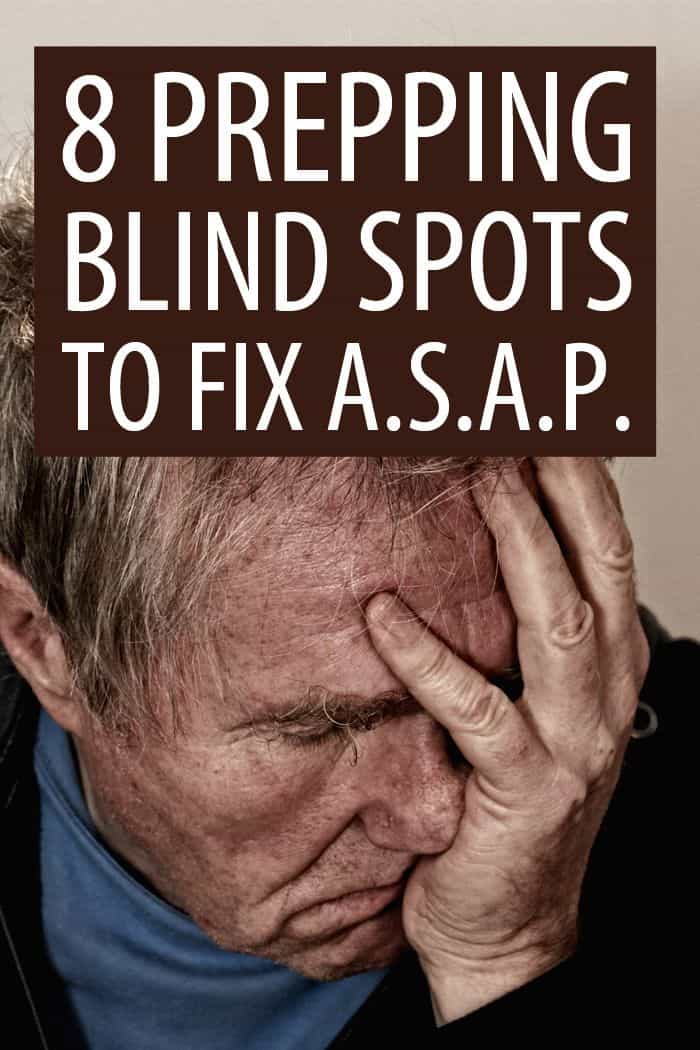

My name is Ryan Dotson and I am a survivalist, prepper, writer, and photographer. I grew up in the Ozark Mountains and in the foothills of the Pocono Mountains. My interest in survival started when I was in Boy Scouts and continued as my father, uncle, and grandfather taught me to hunt and fish. In the last few years I have started taking on survival challenges and have started writing about my experiences. I currently live in Mid-Missouri with my wife Lauren and three year old son Andrew.
